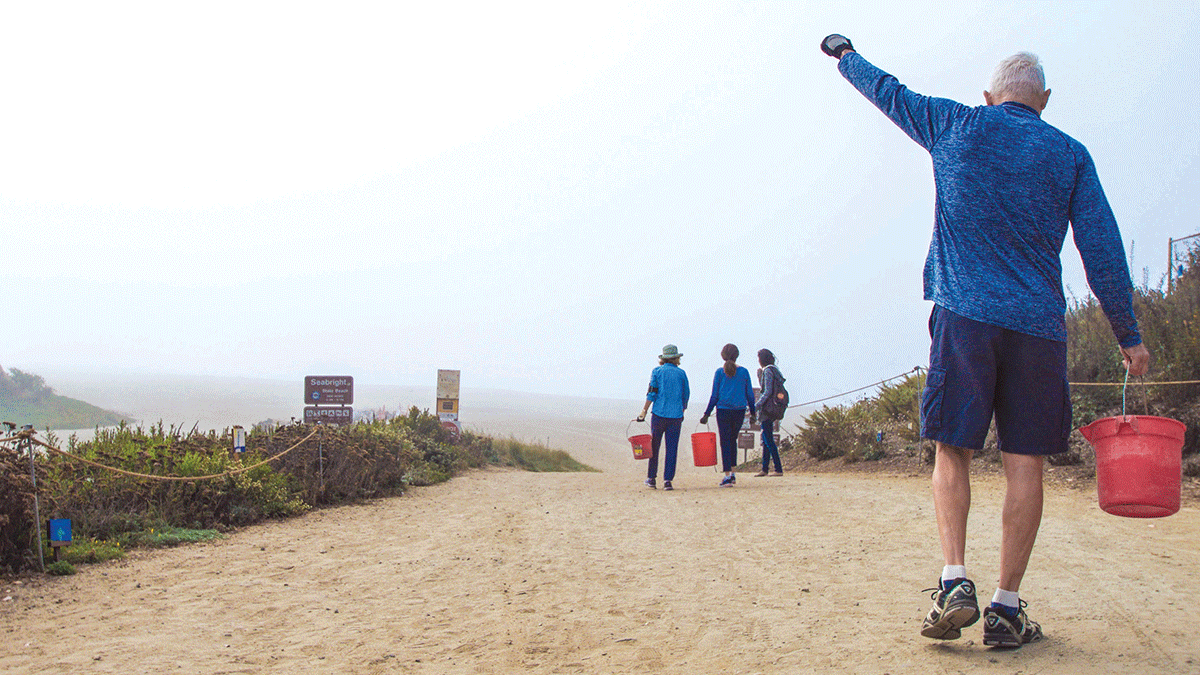Reflecting on 40 years of Save Our Shores, Katherine O’Dea, the environmental group’s executive director, sees a clear path forward for the future of ocean advocacy. That route—as laid out during the nonprofit’s 40th anniversary gala at the Monterey Bay Aquarium—will involve increasingly more legwork and long-term planning. If all goes according to plan, it’ll involve a little less grunt work, too.
“We’re going to continue cleaning our shores,” O’Dea says, cradling a cup of coffee, as guests trickle out of the aquarium and the celebration quiets down. “But we’re hoping through the education initiatives we’ll develop the next generation to have a better environmental ethic, and we’ll be cleaning shores less, because they’ll be cleaner.”
Wearing a sparkling gold-tinged dress, O’Dea spoke to supporters about a new pollution policy campaign targeting six non-essential but ubiquitous plastic products, including single-use toiletry bottles and single-use water bottles.
O’Dea wants local governments to ban the sale of both in the county, and has been working with other environmental leaders like Tim Goncharoff, a resource planner with the Santa Cruz County Department of Public Works.
Goncharoff was one of three award winners Saturday evening when he took home the Ocean Hero award for his work on waste reduction. Santa Cruz Waves won the Ocean Business Award for shining a light on environmental issues, and Keith Grudger won the Ocean Steward Award for developing the Marine Tally app. The app helps Save Our Shores track data and reduce paper usage at clean-ups. Assemblymember Mark Stone (D-Scotts Valley) presented proclamations honoring both Save Our Shores and Dan Haifley, the group’s original director.
Santa Cruz County Health Educator Tara Leonard attended the gala with her husband George, the chief scientist for the Ocean Conservancy. One issue on which they are both focused is reducing the number of cigarette butts that wash into the ocean.
Research on the health risks from smoking isn’t new. Even still, most kids think they’re invincible, Leonard explains, and if someone tries to tell them about the risks of emphysema in 30 years, they’ll simply roll their eyes at the message. “But you show them a picture of a fish with a belly full of cigarette butts,” she says, “and those kids are never gonna smoke.”
Assemblymember Stone introduced a bill for the third time earlier this year banning the sale of cigarettes with single-use filters in them. The first time he introduced the legislation in 2014, it got just two votes in its initial committee hearing. On his second try, Stone pulled the bill, knowing that the committee was going to kill it, anyway. This time, Stone’s proposed filter ban got five votes in its committee hearing, still a few short of what it needed to advance.
Stone knew the bill didn’t have any shot at making it to the governor’s desk this year. But every time he introduces the bill, he says, it furthers the discussion with manufacturers, store owners, constituents and his fellow lawmakers. Many of Stone’s colleagues, for instance, have been surprised to learn that that filters do not make cigarettes any safer to smoke. Cigarette companies do already make filterless cigarettes, although they are not as popular, Stone says.
Leonard has strong feelings about the cigarette butt, calling it “the next plastic straw.” (A new California law makes it illegal for businesses to give out plastic straws unless customers request them.) With the help of a dozen kids, Leonard picked up 3,500 cigarettes earlier this month in Watsonville over the course of just two hours.
“It’s not just trash. It’s a toxin,” Leonard says of the single-use cigarette filter, which is made of cellulose acetate, a form of plastic. “It has all the toxins that we don’t want in second-hand smoke, which is why we don’t allow smoking in restaurants and in our workplaces and in airplanes.”
Early in the evening, at a dinner table surrounded by kelp forests, Jason Scorse says the next phase of ocean advocacy will involve hard work at a number of levels.
Scorse, director of the Center for the Blue Economy, says that best strategies will range from “real mundane shit”—like making sure there are enough trash cans on the beach for Fourth of July weekend—to more visionary thinking and innovative new technology. Scorse, also an associate professor at Middlebury Institute in Monterey, is a former Save Our Shores boardmember who serves on the group’s policy committee.
As he enjoys his vegan dinner, Scorse mentions that he’s impressed by the nonprofit’s new milestone, having made it to 40 years. He stresses, however, that the group can’t look back. He would like to, one day, see the Monterey Bay have the cleanest beaches in the United States—setting an example for the rest of the country.
“We’re not quite there yet. It’s more of an aspiration than a reality,” Scorse says, “but I’ll take that to my grave if necessary.”














